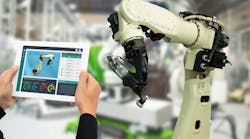Software Can Rewrite Manufacturing’s Future, But Only if We’re Ready
In the past 20 years, the mass digitization of once-tangible products and experiences—from movies, music and books to banking, tax preparation, and more—has brought about a staggering reorder of life as we know it. Today, however, cars, medical devices and other products that are made with traditional manufacturing techniques remain ripe for a similar disruption—and that disruption is moving at intense speed.
We’re on the cusp of a massive paradigm shift. All of the benefits of digitizing content—on-demand delivery, segment-of-one customizations, and more powerful value propositions—are steadily merging with those things in life that still need physicality to be useful. Beyond the value proposition of the products developed for digital processes, the manufacturing chain is similarly empowered by this digital transformation.
Why that shift is so warranted has never been clearer than this year, as traditional manufacturing systems that produce personal protective equipment (PPE) and basic household items have been unable to keep up with increased demand during the global COVID-19 pandemic. We have built a global manufacturing system that values specialization and steady-state optimization over flexibility and resiliency.
It’s not an overstatement to say that new capabilities in how we digitally design and manufacture products as well as how we digitally deliver them will fundamentally change the world. This year was just the beginning, and manufacturing has to be ready for the inevitable. That requires redefining some long-held beliefs—for economic recovery now and in preparation for what’s next. Here’s why.
Creating and Manufacturing Products with Agility and Speed
COVID-19 forced businesses to take stock of their disrupted supply chains to identify exactly how they could be agile. A recent study by PwC found that 80% of manufacturers expect COVID-19 to financially impact their business, compared to 48% of cross-industry businesses. From operational efficiency, to part quality, repeatability and personalization, digital manufacturing technologies helped leaders move fast to make new products and stay viable. This is exactly what we saw from one of America’s largest digital manufacturing facilities when it successfully pivoted to produce tens of thousands of PPE parts within weeks of lockdowns beginning.
Across industries, product development processes are a direct consequence of manufacturing capabilities. ID/CAD/CAM flow is a concession to cost, the lead time of production tooling, and a focus on repeatability. Moving forward, digital manufacturing cannot be seen through the lens of traditional product development paradigms, but rather with the mindset of, “How might this change my entire approach?”
This shift has already happened in the software industry through the rise of agile development methodologies. Years ago, developers knew they had deliver software to their customers through physical media, and the expensive investment that entailed. Burning your code into CD-ROMs, physically shipping them around the world and having limited feedback from customer use drove a waterfall development approach. Measure twice, cut once is the best way to proceed when you only have one chance for success. As digital innovation in creation and delivery of software was enabled, the process of how one can best make software radically changed.
This is starting to disrupt physical goods as well, rewriting the very structure of commerce. Massive storage of physical product goes away. Supply chains realign around a system where a product is sold, then designed or customized, and then manufactured. Selling will trigger the rest of the product creation, manufacturing, and delivery process, minimizing risks for sellers and manufacturers and maximizing value for consumers. Meanwhile, quality management and product lifecycle management start to look a lot like managing code—which is to say, supporting a manufacturing environment where everything contributing to an outcome can be defined in 1’s and 0’s. Going forward, this speed and agility will become a means of resilience and innovation for companies.
Closing the Innovation Gap in Product Delivery and Consumer Demand
Consumers are also vastly different today than they were even a year ago. Accenture research shows 45 percent of global consumers are making more sustainable buying choices since the pandemic began. Meanwhile McKinsey found that as many as 61 percent of consumers are being more mindful of how they spend money since the pandemic and as many as 91 percent have forgone brand loyalty often because supply chain disruptions made it impossible for them to acquire a preferred product. COVID-19 won’t be the last global event capable of setting in motion these kinds of new competitive demands. And the acceleration and evolution of e-commerce we’ve seen is only of snapshot of what’s to come.
This is a new horizon for brands that want to push an entirely new value proposition into the physical world with personalized, affordable and, frankly, cool, products. As our world transitions to an influencer-driven marketplace, microbrands and smaller-run “premium” editions will become the profit leaders across segments. Any industry where consumers want to express their individual personality through product is ripe for this disruption. The automotive industry in particular is one great example. Digital-first auto shops will use digital manufacturing to bring new levels of personalization, driving high-margin part production purpose-built for just one customer. A big carmaker in Europe has already taken that step, producing individualized products—like car wheel inserts, gear knobs and front grills—on-demand and at scale.
A digital approach to product creation and delivery lets manufacturers take the pulse of consumers whose evolving values and preferences will transform every industry. With these capabilities, companies stand to make faster, data-driven decisions, bringing cost savings with previously unattained levels of control and visibility; enhanced repeatability and the velocity to achieve it; and unprecedented productivity and personalization that have the potential to change our world.
Ryan Palmer is global head, Personalization and Industrial Software & Data, HP Inc.




